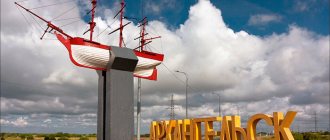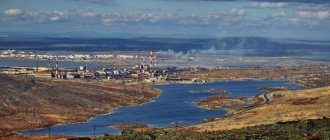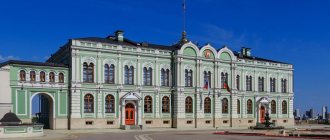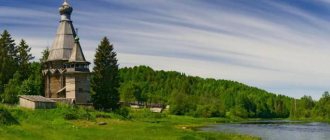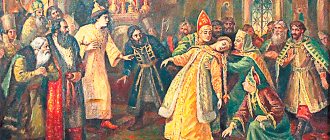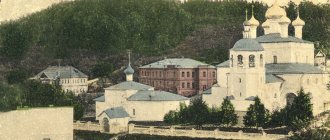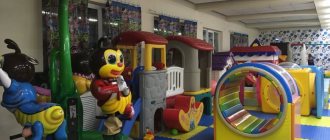A rising star in the brand market
A small polar mining town in the Murmansk region on the border with Finland this year burst into the media space with a new brand “Kovdor - the capital of Hyperborea”: 1.8 million views of the corresponding groups of this project on social networks.
Trails for tourists are being equipped in Kovdor
Photo: Vitaly Ichin
Hyperborea - in ancient Greek mythology and the traditions that follow it, this is a legendary northern country. Many authors localize it specifically on the Kola Peninsula. The mythical dungeons of Hyperborea are included in the fairy tales and legends of the indigenous inhabitants of the Murmansk region. So, to the already well-known places of the Kola region, attracting tens of thousands of tourists - Khibiny (Kirovsk, Apatity), Lovozero, Polyarnye Zorya and Teriberka, which has already gained popularity in the film “Leviathan”, not only a new point on the tourist map has been added, but also a new brand - Kovdor.
Kovdor is located 98 kilometers along a good road from the P-21 St. Petersburg - Murmansk highway (exit from the highway north of Polyarnye Zori). Here, away from the main transport corridor of the Russian North, lies a completely untouched and unknown region. This is a wild area that has not yet been explored by tourists. This is one of the last places in the Murmansk region where no human has often set foot, where any hike is an inevitable encounter with untouched nature, ancient artifacts, and sometimes even bears. Thanks to its remote location and the absence of a border crossing, Kovdor remained off the beaten path.
Local activists studying their native land found several dozen mysterious artifacts in impenetrable taiga places, including the unique Ruby Canyon with the “head of a warrior in a helmet,” a swinging seid, an image of a “star map” on a rock, shaman altars, and many unusual stone buildings. . This is how the movement “Kovdor - the capital of Hyperborea” was born - an association of those who want to study ancient monuments, conduct expeditions, create routes, and develop tourism. Bloggers joined them, and metropolitan journalists and scientists began to join them. At the end of the 1950s, in Kovdor there was a shocking Komsomol construction project for the construction of a mining and processing plant, and today, at the end of the 2010s, there is the same shock entry to the top of the tourism market. Then they “cut down a plant in the tundra,” now they are laying a network of “Hyperborean” tourist routes in it.
The ancient head of a warrior, found by researchers in Kovdor, is more than 20 thousand years old
Photo: Alexander Shvornev
A gift from the past
Located beyond the Arctic Circle, far from other large settlements, Kovdor is the westernmost city of the Murmansk region.
In 1933, an iron ore deposit was found here, near Lake Kovdoro, and twenty years later the construction of a mining and processing plant began, around which a workers’ settlement grew, which in 1965 received the status of a city. Today it is a single-industry town beyond the Arctic Circle. Kovdorsky GOK, which is part of the city, is a city-forming enterprise. EuroChem is actively developing and increasing its mineral production: the Kovdorsky GOK is today the second largest producer of apatite concentrate in Russia and the only producer of baddeleyite in the world. But these are industrial achievements.
In recent years, a new original brand has appeared here: “Kovdor - the capital of Hyperborea.” Hyperborea is a legendary continent from ancient Greek myths, inhabited by enlightened giants who achieved great success in science and art. Ancient authors claimed that it sank to the bottom of the ocean as a result of a large-scale cataclysm.
Some researchers believe that its peripheral areas survived precisely on the Kola Peninsula. As confirmation of this hypothesis, they cite numerous artifacts that are most often found in the vicinity of Kovdor: petroglyphs on rocks, wells going deep underground, step pyramids hewn by time and roads made of huge blocks.
Expeditionary movement
“We have been organizing expeditions around the area every year for a long time, both summer and winter,” says Nikolai Shevelev, an excavator operator at the Zhelezny mine of the Kovdorsky Mining and Processing Plant and an experienced guide to the Kovdor “places of power.” “We recently found and examined a unique object in the Ruby Canyon, 34 kilometers from the city, now we need to study it and develop trails. Of the approximately two dozen ancient artifacts identified, only a few have actually been explored. All of them are in hard-to-reach areas, the path there is extremely difficult.”
Now more and more tourists come to the area to independently make their way through impassable places and explore them. Tourists are not embarrassed by the lack of infrastructure; they know why they are coming. “More and more people are interested in these monuments and our region,” says Ilnur Safin, chairman of the council of young specialists of the Kovdor plant and head of the Hyperborea club. “We need to figure out who built all this and why, and involve scientists.” We thought we needed to move all this, promote it, and organized the Hyperborean movement in honor of the ancient northern civilization.”
Now, not only ore is mined in Kovdor - local historians and visiting tourists, the number of which is increasing, are “mining” the ancient northern culture, looking for the meaning of life, trying to feel involved in ancient energies. “Why go to Tibet for 240 thousand rubles, when you can come to Kovdor with the same energy,” says Oleg from St. Petersburg, an experienced traveler to “places of power”, one of the participants in summer expeditions. This season alone, leading Russian bloggers, journalists from Komsomolskaya Pravda and Echo of Moscow visited here. The autumn, winter and next summer expeditionary landings have already been scheduled.
Kovdor land contains many mysterious buildings
Photo: Mikhail Frolov, “KP” - Moscow
Win the competition for Hyperborea
However, Kovdor, like the Kola Peninsula, has great competition among contenders for the title of Hyperborea. Today, many countries and regions are trying to localize it “at home.” Disputes about the location of the mythical continent began with Greek historians and continued by medieval intellectuals. The origin of many material traces and artifacts of a certain ancient, pre-glacial civilization are scattered throughout the European north and have not been explained to this day.
The topic of Hyperborea in the strictly scientific sense as a systematic search, study and interpretation of artifacts and megalithic structures appeared at the turn of the 19th-20th centuries, as a by-product of the “raw materials development” of the north. Then all powers actively divided this region, rich in resources. Numerous geological expeditions “at the same time” discovered ancient monuments. The first explanations of historians, philosophers, and anthropologists of these finds were, in today's opinion, quite crude, but, nevertheless, they gave rise to numerous today's “paranormal” literature.
Today's situation with Hyperborea is unique. Firstly, in fact, no one has really, systematically studied it yet. Several studies conducted by enthusiasts do not make a difference. Today there is not even a consolidated map of the ancient megaliths of the Kola Peninsula. Therefore, the Kovdor project is a great blessing, because it should stimulate scientific research through mass interest. Secondly, today, at the beginning of the 21st century, competition for Hyperborea itself has begun - only now, when the time has come for wars for the civilizational heritage, it has become clear that a cultural resource is much more important and more expensive than a raw material one.
Within Russia, among the contenders for the localization of Hyperborea, in addition to the Murmansk region, are Karelia and the Urals. Everyone has their own arguments, but the scale of the artifacts and the great antiquity of the territory speak in favor of the Kola Peninsula - part of the Baltic Shield, which is the oldest part of the earth's land, the geological structures here are the most ancient in Russia and Europe. The heritage of the Urals and Karelia, unlike Kovdor, has, in general, already been studied, and the artifacts there date back to later periods. But the Murmansk region still remains a tabula rasa - no one knows what else will open here and what can be found.
Kovdor youth are the main driver of the project “Kovdor - the capital of Hyperborea”
Photo: Alexander Shvornev
Intellectual battle at Kovdor
If you look at the map of ancient artifacts, Kovdor appears at the center of the broad Russian-Finnish Hyperborean cultural region. It is, according to the initiators of the project, the geographical and symbolic capital of Hyperborea.
The residents of Kovdor by posing the question in this way “cause fire upon themselves,” invite everyone to come to them: see for yourself, let’s explore the Russian North together! Join us, come and figure it out for yourself on the spot - go on an expedition with local pathfinders, look at numerous artifacts, take part in discussions, listen to lectures by learned historians and geologists, feel yourself in Hyperborea. And give your verdict!
The battle of intellectuals for Hyperborea is just beginning. The intellectual debate about Hyperborea - where it is and what it is like - which was waged by ancient and medieval authors, and then by Soviet explorers of the north, has now been transferred to the Murmansk region, to Kovdor.
For the first time in the world, the theme of Hyperborea became a large-scale practical cultural project. It is accessible to everyone and is associated with intellectual tourism. Hyperborea gave its name to several small events, recreation centers and festivals in Karelia and the Murmansk region. But there has not yet been a large-scale socio-cultural project. The active residents and administration of Kovdor had enough assertiveness to move the matter forward. Here they hope that the local team will have the skill to make Kovdor the capital of Hyperborean research.
Links[edit]
- ^ a b https://www.mojgorod.ru/murmansk_obl/
- ^ abcd Administrative-territorial division of the Murmansk region
, p. 57 - ^ a b Federal State Statistics Service (2011). All-Russian Population Census 2010. Volume 1 [All-Russian Population Census 2010, vol. 1]. All-Russian Population Census 2010 [All-Russian Population Census 2010] (in Russian). Federal State Statistics Service.
- "26. The size of the permanent population of the Russian Federation by municipalities as of January 1, 2021". Federal State Statistics Service. Retrieved January 23, 2021.
- "On the Calculation of Time". Official Internet portal of legal information
. June 3, 2011. Retrieved January 19, 2021. - Information about local messages https://www.russianpost.ru/PostOfficeFindInterface/FindOPSByPostOfficeID.aspx?index=18400
- ↑
Federal State Statistics Service of Russia (May 21, 2004). The population of the Russian Federation as part of federal districts, urban settlements, settlements, settlements, settlements, settlements, settlements, settlements, settlements, settlements, settlements settlements, settlements, settlements, settlements.[Population of Russia, its federal districts, constituent entities of the Federation, districts, urban settlements, rural settlements - administrative centers and rural settlements with a population of more than 3000 people] (XLS). All-Russian Population Census of 2002 [All-Russian Population Census of 2002] (in Russian). - All-Union Population Census of 1989 Population of Union and Autonomous Republics, Autonomous Regions and Districts, Territories, Regions, Urban Settlements and Village District Centers [All-Union Population Census of 1989: Current Population of Union and Autonomous Republics, Autonomous Regions and Districts, Territories, Regions , districts, urban settlements and villages performing the functions of district administrative centers]. All-Union Population Census of 1989 [All-Union Population Census of 1989] (in Russian). Institute of Demography of the National Research University: Higher School of Economics [Institute of Demography of the National Research University: Higher School of Economics]. 1989 - via Demoscope Weekly
. - "About EuroChem". EuroChem. 2011. Archived from the original on November 20, 2011. Retrieved November 8, 2011.
- Information about the Kovdorsky district and the Kovdorsky GOK
The Russian North is back in fashion
North is cool, this is a story about real travel. After a 25-year pause, a gigantic interest in the Russian north arose, and a second wave began. In the late 1960s - 1970s, during the first wave, there was a massive boom in northern tourism in the USSR. Songs and literature appeared promoting the region. My parents were active participants in the all-Union people's movement of polar romance with kayaks, hills, and a guitar around the fire. We are still watching a film recorded on 8-mm film about a grandiose multi-day trip to Lovozero with all the adventures - mosquitoes in the porridge, repairing kayaks, meeting a mother bear with cubs, playing cards (whoever loses eats a frying pan of fish), spending the night on a desert island after storms I think many families have similar stories.
In the 1990s, something was added that Russians acquired in the wake of perestroika: freedom of the media and any statements, interpretation of everything secret and unknown. Numerous “researchers” appeared who filled the topic of northern landscape anomalies and Hyperborea with paranormal explanations. Hence all these UV rays, UFOs, karma, aura, Shambhala, space, cosmic rays, aliens, northern pyramids.
The Hyperborea festival brings together the most active
Photo: Alexander Shvornev
Now there is a new wave of interest in the north: more services, accessibility, technology, but the essence remains the same - to explore and test yourself, to open new horizons of knowledge within yourself.
The “Northern Revolution” is in full swing. It has already reformatted the markets for documentary films and magazine photographs, sports and tourism equipment, as well as products - fish, venison, and northern cuisine restaurants are now more popular than ever. There are already more than a hundred successful projects in Russia created based on interest in the north.
The “Northern Revolution” is based not only on the consumer’s craving for the unique northern nature, but also on people’s demand for places where “people are tested.” Behind every northern selfie there is essentially a message: “I passed the test,” “I was able to be there.” This is not only a request for ecology and an active, healthy lifestyle (today’s trends), but also a request for an understanding of who you are, besides the fact that you are a resident of a metropolis. The north and the history of northern civilization test people. People want to understand the mystery of the north, withstand the test of the north, touch the “places of power” in order to become stronger themselves.
The Kovdor Hyperborean project was started by strong people from the northern city - they want to understand their mysterious land, its history, to understand and find themselves - and they invite you to join them in this search.
Coat of arms
City coat of arms
Date of adoption: 10.1980
Description: The shape of the coat of arms is based on a French shield crossed by a gold belt with a jagged protrusion at the bottom. The belt represents a stylized image of an iron ore quarry with its sides depicted. On the tip of the black color is the gold symbol for the chemical symbol of iron, Fe. In the upper silver field there is a gold “compass rose” superimposed on a black ball. The diagonal elements of the “wind rose” symbolize magnetite crystals, which are shaped like octahedrons. The contrast of the silver and black colors of the coat of arms means: the decisive intervention of a person who wants to have black metal in the virgin snow-covered nature of the North.
The author of the coat of arms is the architect Mikhail Ivanovich Yakovlev.
Cognition and Posting
The new generation is choosing a new type of tourism product - individual, local, educational, “Instagrammable”. Today's active tourist is focused on a completely independent search; he wants an individualized product. The tourist seems to be saying: I don’t need a standard tour, just give me the infrastructure - transport, a hotel, camping sites - and I’ll decide everything myself, where and how I should go, I’ll see everything myself. He wants exactly his journey, his Hyperborea.
The modern tourist no longer travels only “for the fog and the smell of the taiga,” but also for the spirit, strength and atmosphere of the place. He needs to feel a real connection with him. The spirit of a place cannot be bought, it must be known, it must be touched, encountered. Hyperborea is the experience of contact with the ancient, with nature, with history, with Time. New “places of power” of the Kola Peninsula have been discovered in Kovdor, and the modern tourist wants to see these portals to another dimension, to feel the energies emanating from the local objects of Hyperborea - unusual stone buildings on the Topor River, shaman altars, a swinging seid, a pearl waterfall, a map of the starry sky , Ruby Canyon.
The spirit of knowledge, research and search is the new tourism trend. Today we see a huge demand for expeditions. Before our eyes, the entire tourism market is turning into educational tourism. Hyperborea is an eternal mystery, a mystery interesting for any age. This is also a good basis for family and children’s tourism, experts say. “Attitudes towards science and the public’s demands are changing for the better, I see great interest,” says Murmansk archaeologist Viktor Ivanov. — Previously, no one was particularly interested in our excavations, they dug and dug, but now summer children’s archaeological camps and family local history hikes are gaining popularity. In general, you now have to sign up for any children’s educational camps a year in advance.” On the Kola Peninsula, through the efforts of many enthusiastic scientists (a good example is in Kirovsk), geological and mineralogical tourism is gaining momentum. Groups from Murmansk, St. Petersburg, Moscow go on hikes and study the most ancient and geologically interesting region of Russia. This is mainly the Khibiny Mountains, but the organizers of the project “Kovdor - the capital of Hyperborea” also plan to conduct mineralogical tours, since the area has unique geology - mica, rubies, iron ores. Next year it is planned to hold a summer children's mining school and create educational mineralogical kits.
Kovdor Hyperborea, say bloggers who have been there, is one of the best locations for selfies. The proof is the boom of photographs on social networks, there are already thousands of them. For the millennial generation, social networks, selfies and travel are in the first place, they are the ones that determine behavior - people travel, constantly photograph the places they have visited, and post it all online. Everything now exists through continuous posting. That's why Hyperborea has become so popular on social networks.
Guides to Hyperborea
In the new tourist trend, the role of the guide is important - he is now not only an instructor, but also in some way a stalker, feeling exactly how to navigate through energy fields and secret paths so that the place will “let you in” and open up to you. He is also a storyteller, sharing experiences, showing what cannot be seen on one's own.
The Komsomolskaya Pravda expedition is studying ancient stone blocks of ideal shape
Photo: Mikhail Frolov, “KP” - Moscow
Kovdor residents are guides to Hyperborea, stalkers, trackers... A Kovdor man can tell a lot, he has a unique long-term experience of interacting with nature, a sense of place.
For a small town, more than 150 people—professional participants in the tourism movement—is a big number. The local tourist club "Horizon" annually conducts all-season hikes in the Kola Arctic, Kamchatka, Georgia, Kyrgyzstan, rafting on the Kola Peninsula, master classes on tourism, and participates in international tourist rallies. Here this is a way of life, everyday life, normal abilities for every resident, because the impenetrable taiga, hills and swamps begin immediately outside the city border.
Today Kovdor is a center for guides to the secret world of the Kola landscapes, a treasure trove of instructors, kayakers, and specialists in minerals and mountain hikes. This is the birthplace of unique competencies. Not only do 200-ton truck drivers, mining engineers, blasters, technologists and geologists live here, but also more than a hundred professional instructors. Every Kovdor resident goes camping at least once a year; everyone knows how to hike in the mountains and kayak. And next year, a unique All-Russian youth school of tourist instructors will be held here with the participation of youth teams from 29 regions.
Kovdor - the capital of Hyperborea
It is believed that this stone, standing on a sharp end, serves as a beacon for UFOs.
Photo: Mikhail FROLOV
In the last issue we talked about amazing stone artifacts on the Kola Peninsula, which a number of scientists attribute to objects created by man before the last ice age. If the scientists' opinion is confirmed, it will create a sensation in our knowledge of human history. Today we continue the story about the mysterious finds on the Kola in the area of the city of Kovdor, which is already considered the capital of that ancient civilization - Hyperborea.
The capital of Hyperborea is considered to be the city of Kovdor, 200 km southwest of Murmansk. Near the city there is a huge quarry half a kilometer deep. But these are not excavations of Hyperborea, but the extraction of iron ores, apatites and expensive zirconium.
This monument to the Hyperborean warrior near Kovdor is apparently the oldest on Earth. Photo by: Alexander SHVORNEV
The administrative director of the Kovdorsky GOK, Ivan Fomin, told us briefly the history of the enterprise.
— In 1933, geologists here, in the area of Lake Kovdor, discovered a huge deposit of excellent iron ore, which should have been sent to Leningrad for metal rolling. By June 22, 1941, a railway was built here almost to the mine. But they immediately began to dismantle the rails so that the enemy would not get them. From Kovdor to the Finnish border it is only 17 km. And then only in the fifties the first builders moved here. In addition to iron ores, phosphorus was also discovered here, and this is a wonderful fertilizer. The proven ore reserves alone will last for another 100 years. And we still don’t know how much more may lie at depth. Therefore, Kovdor is very attractive to both Finns and other European specialists.
The nearest Finnish villages are about 70 kilometers from here, but there is no direct road, which hinders relations with Europe. However, the road issue, according to Ivan Ivanovich, is now being considered at high levels. And if everything works out, then travel from Murmansk to St. Petersburg through Kovdor and Finland will reduce the distance between these cities by 120 kilometers.
- Ivan Ivanovich, Kovdor is known to be the capital of Hyperborea. What do you think Hyperborea is?
- I think that this is a civilization even more ancient than Atlantis. There are traces that indicate the presence of ancient life in our region. There are many stone blocks on which you can see signs of processing even after more than ten thousand years. I myself have seen stones arranged in an order in which nature could not have arranged them. And this is why we are attractive to tourists and scientists. We would be happy to cooperate with researchers and are ready to provide them with any assistance.
In Kovdor, salaries are high and housing is cheap
The head of the Kovdorsky district, Sergei Somov, is also eager to reveal ancient secrets.
— Hyperborea is a pre-glacial civilization, from which little remains. And now we want to understand where it came from and where it went. Therefore, it is important for us to attract scientists who, unlike us, can read the landscape. There are vast expanses here, where not only a researcher, but also an ordinary person has never set foot.
In this gigantic quarry, like everything else here in Hyperborea, ores and apatites are mined.
Photo: Mikhail FROLOV
— What is attractive about Kovdor, besides Hyperborea?
— We have very cheap housing. A 3-room apartment can be bought for 600 - 800 thousand. Fishing, berries. Our mushrooms are collected directly from the trunks of cars. There are no problems with places in kindergartens. You can let your child go outside and not worry. Two and a half hours to the airport on a good road, and you can fly to Moscow, St. Petersburg or somewhere else. Prices in stores are not higher than in Moscow. Now salaries for the necessary specialists - doctors, teachers and others - range from 70 to 100 thousand rubles. There is no need for a specialist to buy an apartment; we will give it to him for commercial rent. And if he signs a contract for 5 years, then after this time he will receive this apartment for free. We are currently working on the issue of laying a road to Finland. The Finns are sleeping and see us coming to them. If it works out, then a huge flow of Chinese tourists will pour into Finland through Kovdor, who are now going to Murmansk to see the nuclear-powered icebreaker "Lenin", the northern lights, Hyperborea and other things.
— If you believe the locals, even snow people live here.
“We really have places where you walk through the forest and feel like someone is looking at the back of your head. Sometimes you take it absolutely calmly, and sometimes you are overcome with panic and suddenly begin to wander. This has happened to me personally, and more than once. One of our guards guarded the base on a rainy night in the fall. And suddenly someone knocks on the door. The watchman asks: who is there? Silence. Another knock. And so on several times. The watchman couldn't stand it, he opened the door, there was no one there. And no traces were found in the morning. On the same day he resigned of his own free will.
Bigfoot has been around here for a long time
Galina Kulinchenko, head of the local history museum in the village of Lovozero, expresses her opinions about Hyperborea.
— There is a version that the Indians are the descendants of the Hyperboreans who came to India to escape the cold weather. Other researchers believe that the Hyperboreans were very tall, as evidenced by the huge stone blocks with which they worked.
— Many people here talk about Bigfoot.
— In the 80s, in our Lovozero area, about 8-9 boys went fishing and settled in a hunting hut. They were 15 - 17 years old. And so they were returning from the lake. The first group passed through the stream, the second approached the stream. Suddenly this creature appears and jumps across the stream towards the first group. One boy immediately started running. The creature behind him, but did not catch the boy, but smeared his back with its paw. The second group rushed to Lovozero and jumped into the motorboat. They raised up the district police officer, game warden Pavlov and two rangers. For some reason the local police officer didn’t go, but the others did. Then Pavlov said: when we arrived, he said, we saw his head and shoulders behind the bushes. We did not dare to approach the shore. We drove along the shore, and the creature ran parallel. Moreover, it did not even run, did not jump, but seemed to float through the air in another space.
Is the Baltic Shield the ancestral home of humanity?
Vladimir Kuznetsov is the director of the Center for Television and Video Art in the village of Lovozero. He is also a local historian. Vladimir Mikhailovich believes that the Kola Peninsula could have been the cradle of humanity.
— We are on the Baltic shield. It rose from the ocean two and a half billion years ago. It is quite possible that this is where the very first human civilization arose. Then the glaciers licked up almost everything. Animals and people, if they lived here, went south. The height of the glacier was 2 - 3 kilometers, and it was creeping south at a speed of half a meter per hour.
— If we assume that the highly developed Hyperboreans went south from here, they should have preserved and passed on their history to us?
— Scientists have found mammoths with undigested grass in their stomachs. This suggests that their death was instantaneous. Most likely, from some kind of cataclysm. It is possible that the cataclysm instantly killed the human northern civilization. And if some people survived, they had no time to preserve their history for posterity.
The Kovdor quarry is also one of the beautiful places in Hyperborea.
Photo: Mikhail FROLOV
Ruby Canyon
Once in Soviet times, a group of geologists, making their way through the taiga, 30 kilometers from Kovdor, came across a statue of a huge stone head of a warrior in a helmet. After much debate - whether this miracle was man-made or natural - geologists began to carefully study the place. And as a result, they found placers of corundums here, those that would later turn into rubies. And recently, Kovdor local historians discovered a huge stone wall here, made of giant blocks, similar to the remains of an ancient city. This place, like other attractions of Hyperborea, is far from explored and awaits its researchers. Next year, at the invitation of the municipality, an archaeological expedition will arrive here and will certainly surprise us with its discoveries.
Not far from Kovdor, on the slope of one of the hills, there stands a huge and wonderful stone. Moreover, it stands, resting against the slope with its sharp edge. There are a couple of pebbles under the edge so that the giant can hold on. To joke like that, you need up to 300 healthy men to lift the giant here with ropes. Therefore, locals believe that the stone was not installed by human hands. Perhaps it serves as a landmark for UFOs or a monument to the ancient Hyperboreans. Not far from the stone are again mysterious slabs and huge, juicy plantations of blueberries and blueberries. We ate them and ate them...
So, the Komsomolskaya Pravda expedition saw many Hyperborean mysteries in these places, but did not solve any of them. And we didn’t have such a task. Let's leave these secrets to scientists, who, we hope, will come to this wonderland.
Hyperborean tourism cluster
In just a year, Kovdor managed the unthinkable - to form and prepare routes, begin construction of a park and reconstruction of a tourist center, and involve external players in the project: bloggers, journalists, officials, and tourism specialists.
Today, six routes have already been tested, there are guides and instructors. Starting from the next season, Kovdor is a supporting tourist center, from which radial short introductory trips and long expeditions around the area to the artifacts of ancient Hyperborea are carried out.
The residents themselves began to build a park with Hyperborean artifacts, update the geological exhibition telling about amazing minerals, and held the first international Hyperborean ethno-historical festival.
“We want Kovdor to become a point of growth, the capital of the research movement, a tourist center,” says the head of the Kovdor district, Sergei Somov. “That’s why we attract scientists here who, unlike us, know how to read the landscape. They see what we don't notice. There are vast expanses here, where not only a researcher, but also an ordinary person has never set foot. At the same time, we are already “raising” the infrastructure - expanding accommodation options, equipping trails, and reviving the tourist center.”
Yes, the infrastructure here is not yet developed compared to Finland and, for example, the Khibiny Mountains, but the territory itself is much more interesting. Over time, the tourist who is now traveling to Finland and the Khibiny Mountains will “taste” Kovdor. The presence of a hotel and camp site, ski and sports complexes, a well-thought-out route scheme, professional support, an interesting tourist product based on smart educational tourism and family educational programs, ethnic festivals, children's Hyperborean camps, and, in the future, the opening of a border crossing with Finland - will create a multiplier effect .
Border is locked tight?
Today, in the Murmansk region there are two international automobile checkpoints on the border with Finland: Salla and Lotta (Raja-Joseppi). In addition, there is a checkpoint Borisoglebsk (Storskog) on the border with Norway. But this doesn’t make it any easier for Kovdor.
— A paradoxical situation arises: Finland is only 26 kilometers away, but to get there you need to make a detour of 320 kilometers. It is clear that neither we nor they will visit us again,” explains the head of the local travel agency that carries out cross-border cooperation with partners from Finland, Artur Belyanin.
Young people are slowly leaving the city, although the presence of a checkpoint and, as a consequence, the development of international tourism would help create new jobs, and therefore new prospects for Kovdor residents.
In addition, the opening of the road would increase the investment attractiveness of the area and contribute to the development of trade relations between local enterprises and Finnish partners.
And the Finns would not be averse to creating a common tourist route with Kovdor. They themselves promote “Gerda’s Path to the Snow Queen”; Rovaniemi, the residence of the Finnish Santa Claus, is located nearby. Finally, there are Sami communities on both sides of the border. Representatives of this small people would be able to communicate with their fellow tribesmen and develop cultural exchange if an international automobile checkpoint appeared.
The head of the Kovdor district imagines in detail a road that can lead the municipality out of a dead end:
— Today it is unpaved, 26 kilometers. You can leave it unpaved for the first period, but make the surface so that you can drive a car. Four kilometers will be built entirely from scratch - between Russia and Finland on neutral territory, and about 30 kilometers - on the Finnish side. Plus the checkpoint itself,” Sergei Somov enthusiastically explains.
The price of the issue is not yet known exactly: the municipality has not yet ordered an official road project. But, according to the director of the Institute of Transport Economics and Transport Policy at the Higher School of Economics, an expert in the field of transport and road infrastructure, Mikhail Blinkin, four kilometers of primer with decent coverage will cost 10 million rubles. A road category 1A (motorway) or 1B (expressway) will cost 10 times more. Completing the work, if desired, is a matter of one construction season.
Warrior's Head in Ruby Canyon
It seems that Kovdor has found its unique niche - unexplored landscapes, off-the-beaten paths, ancient heritage, mineralogy, exciting expeditions. If in other places - Petrozavodsk, Kirovsk - everything is more or less clear and standard, then here the story is just beginning.
Tens of kilometers along a dirt road, kilometers of walking uphill through a scattering of northern berries, a dangerous path among stone crevices densely overgrown with moss and ferns - and you are in Ruby Canyon. The remains of an ancient city were discovered here - a stone wall made of giant stones and overgrown with centuries-old pine trees. The entrance to the canyon is guarded by a huge warrior’s head - a rock on which a human face clearly appears.
Not far away, near a mountain river, they began to restore a camp site; next year it will be ready for the arrival of researchers.
The stone warrior, which, according to historians, is more than 20 thousand years old, looks from above at a new interesting history being born in Kovdor.
